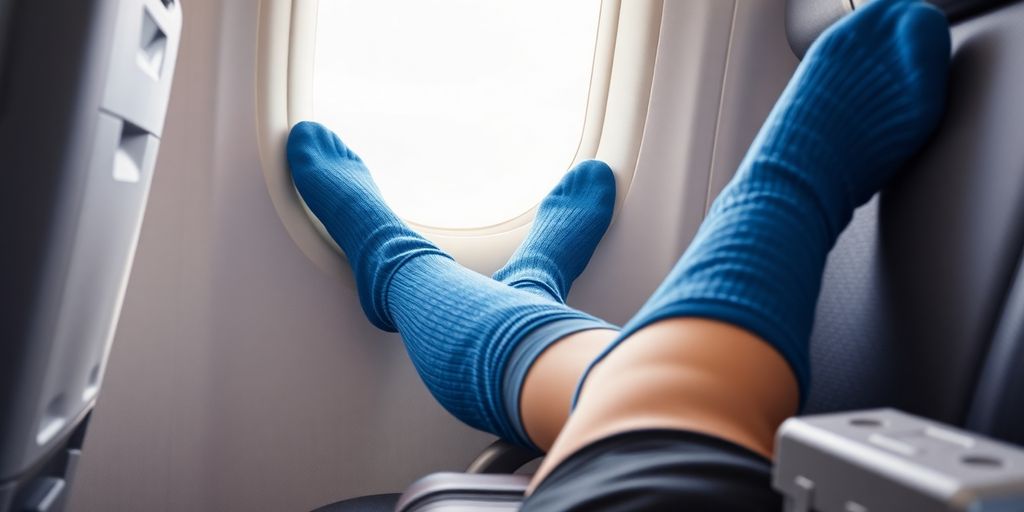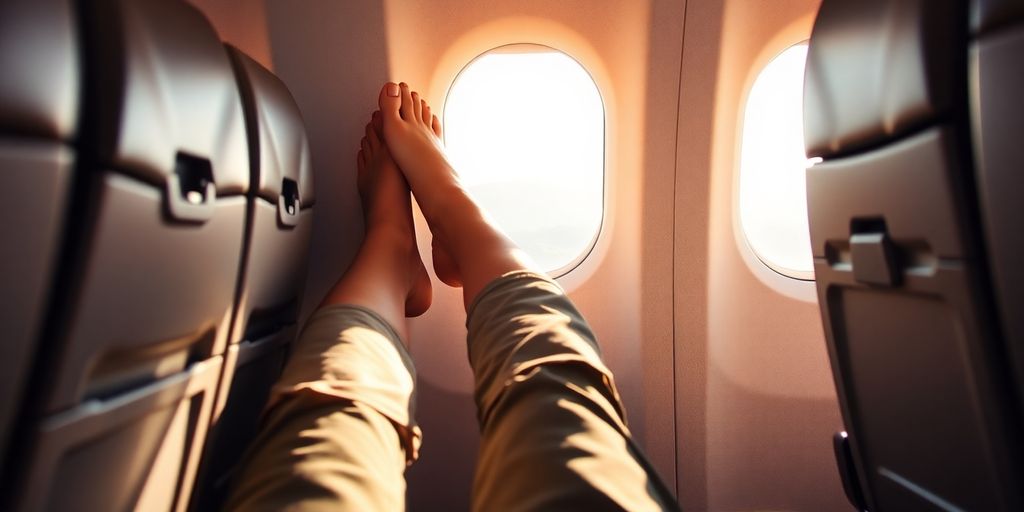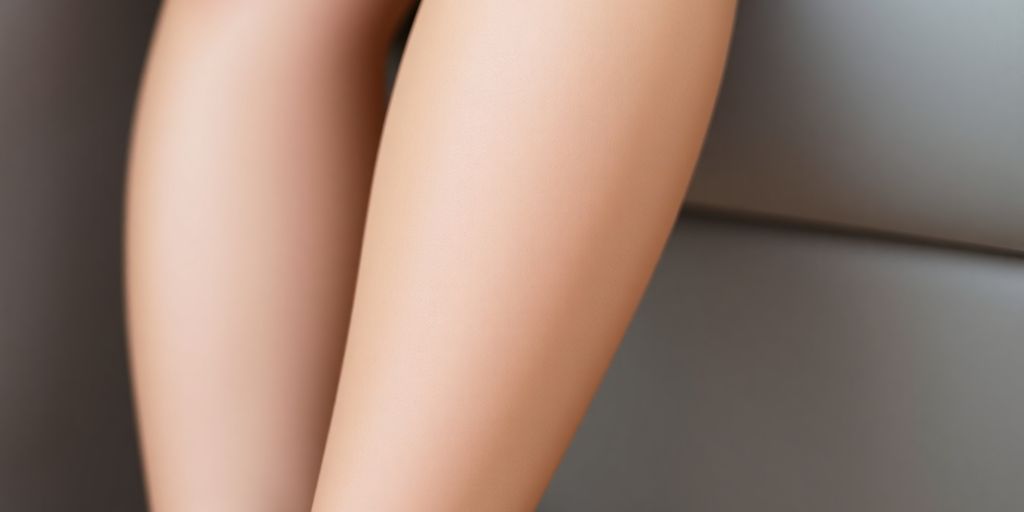Is it good to wear compression socks when traveling? I kept asking myself that before my last long-haul trip. My legs were stiff and swollen by the time we landed, so I finally gave them a try. Spoiler: they helped, but only if you pick the right kind, put them on right, and mix in a few simple habits.
Key Takeaways
- Compression socks can cut down leg swelling and stiffness on long trips by keeping blood moving.
- Choose a light to medium pressure level and get snug calf and ankle measurements to avoid squeezing too much or too little.
- Put them on before you sit for a long time, smooth out any creases, and keep them on from start to finish.
- Watch for red marks, pressure spots, or itching—if anything feels off, stop wearing them and talk to a healthcare provider.
- Drink plenty of water, flex your feet in your seat, take short walks when you can, and wash your socks after each trip to keep them working well.
Benefits Of Compression Socks On Extended Travel
Reducing Leg Swelling During Long Stays
Long trips, whether by plane, train, or car, often mean sitting for hours. This can lead to fluid buildup in your legs, causing swelling and discomfort. Compression socks apply gentle pressure that helps prevent this fluid accumulation. They encourage better circulation, pushing blood back towards your heart and reducing that heavy, swollen feeling. It's a simple solution that can make a big difference in how you feel after a long journey. Think of it as giving your legs a gentle squeeze to keep things moving.
Supporting Healthy Blood Flow
Sitting still for extended periods can really slow down your blood flow. Compression socks are designed to counteract this. By gently squeezing your legs, they help your veins pump blood more efficiently. This is especially important during travel, as reduced activity can increase the risk of blood pooling in your legs. Improved blood flow not only reduces swelling but also helps prevent fatigue and discomfort. Wearing travel compression socks is like giving your circulation a little boost when it needs it most.
Minimizing Risk Of Deep Vein Thrombosis
Deep vein thrombosis (DVT) is a serious condition where blood clots form in the deep veins, usually in the legs. Long periods of inactivity, like during travel, can increase this risk. Compression socks can help minimize the risk of DVT by promoting healthy blood flow and preventing blood from pooling. While they aren't a foolproof solution, they are a proactive step you can take to protect your leg health during travel. If you have concerns about DVT, it's always best to consult with a healthcare professional. Wearing compression socks is a simple preventative measure, but it's not a substitute for medical advice.
Wearing compression socks during travel is a simple yet effective way to support your leg health. They help reduce swelling, improve circulation, and minimize the risk of DVT, making your journey more comfortable and safer. Remember to choose the right fit and compression level for optimal benefits.
Selecting The Right Travel Compression Socks

Choosing the right compression socks for travel isn't just about grabbing any pair off the shelf. It's about finding the perfect fit and compression level to keep your legs happy on those long journeys. Let's break down what to look for.
Determining Appropriate Compression Level
Compression levels are measured in mmHg (millimeters of mercury), and it's important to get this right. For most travelers, a moderate compression level of 15-20 mmHg is ideal. This level provides enough support to improve circulation without being too restrictive. If you have pre-existing conditions, like varicose veins or a history of DVT, talk to your doctor about whether a higher compression level is right for you. Remember, more isn't always better!
Ensuring Accurate Measurements
Getting the right size is just as important as the compression level. Socks that are too tight can cut off circulation, while socks that are too loose won't provide any benefit. Measure your calf circumference and leg length according to the manufacturer's instructions. Here's a quick guide:
- Measure your ankle circumference at the narrowest point.
- Measure your calf circumference at the widest point.
- Measure the length from your heel to just below your knee.
Accurate measurements are key to finding compression socks that fit well and do their job effectively. Don't skip this step!
Choosing Breathable And Durable Fabrics
Long flights can get stuffy, so breathable fabrics are a must. Look for materials like cotton blends, merino wool, or synthetic fabrics designed to wick away moisture. Durability is also important, as you'll want your compression socks to last through multiple trips. Here are some popular options:
- Cotton Blends: Comfortable and breathable, but may not dry as quickly as synthetics.
- Merino Wool: Naturally moisture-wicking and odor-resistant, great for longer trips.
- Nylon/Spandex Blends: Durable, stretchy, and quick-drying, ideal for active travelers.
Proper Application And Wear Techniques
Okay, so you've got your travel compression socks. Now what? Putting them on and wearing them correctly is just as important as picking the right pair. It's not rocket science, but a few simple steps can make a big difference in how effective they are and how comfortable you feel.
Putting On Socks Before Boarding
Seriously, put those socks on before you even think about getting on the plane. Trying to wrestle them on in that tiny airplane bathroom is a recipe for disaster. Your best bet is to put them on first thing in the morning, before your legs have a chance to swell. This makes it way easier to get a snug, even fit. Plus, you'll avoid any awkward moments trying to balance in a cramped space.
Smoothing Out Wrinkles To Prevent Pressure Points
Wrinkles are the enemy! Seriously, they can create pressure points that dig into your skin and cause discomfort, which defeats the whole purpose of wearing compression socks in the first place. Take the time to smooth out any bunching or folds as you pull them up. Make sure the sock is evenly distributed along your leg. If you're having trouble, try using rubber gloves – they can help you grip the fabric and get a smoother fit.
Maintaining Consistent Wear Throughout The Journey
Once those socks are on, leave them on! The whole point is to provide continuous support and promote healthy blood flow. Don't take them off mid-flight unless you absolutely have to. If you do need to remove them, try to put them back on as soon as possible. Think of it like this: they're working hard to keep your legs feeling good, so let them do their job for the entire duration of your flight.
Wearing compression socks correctly can really make a difference in how you feel after a long trip. It's all about preparation and attention to detail. A little effort upfront can save you a lot of discomfort later on.
Potential Risks And Who Should Seek Advice

While compression socks are generally safe, it's important to be aware of potential downsides and know when to consult a professional. I mean, it's better to be safe than sorry, right?
Identifying Signs Of Improper Fit
Okay, so you've got your compression socks. But how do you know if they fit right? Well, if they're too tight, you might notice things like excessive indentations on your skin after you take them off. That's not a good sign. Other things to watch out for:
- Numbness or tingling in your toes.
- Increased pain or discomfort in your legs.
- Changes in skin color (like paleness or blueness).
- Blisters or skin irritation developing under the sock.
If you experience any of these, take the socks off immediately. It might just be a matter of adjusting them, but if the problem persists, you might need a different size or compression level. Don't just tough it out!
Recognizing Skin Irritation Risks
Sometimes, even with a good fit, your skin might not like the socks. This can happen for a few reasons:
- Material Sensitivity: Some people are allergic or sensitive to the materials used in compression socks (like latex or certain synthetic fibers). Look for socks made with hypoallergenic materials if you have sensitive skin.
- Poor Hygiene: Not washing your socks regularly can lead to a buildup of bacteria and fungi, which can irritate your skin. Wash your compression socks after each use.
- Excessive Moisture: If your feet sweat a lot, the moisture trapped inside the sock can cause irritation. Consider using a foot powder to help absorb moisture.
If you notice redness, itching, or a rash, stop wearing the socks and let your skin recover. You might need to switch to a different brand or material. Also, make sure you're using a gentle, fragrance-free laundry detergent to wash them. Prevention & Treatment options are available if irritation occurs.
Consulting A Healthcare Provider When Necessary
For most people, compression socks are perfectly safe. However, there are certain situations where you should definitely talk to a doctor before using them. These include:
- Existing Circulatory Problems: If you have conditions like peripheral artery disease (PAD), you need to be extra careful. Compression socks could potentially worsen the condition.
- Diabetes: People with diabetes often have reduced sensation in their feet, making it harder to notice problems caused by improperly fitting socks.
- Skin Infections or Open Wounds: Compression socks can increase the risk of infection or delay healing if you have any breaks in the skin on your legs or feet.
- Heart Failure: In some cases, compression can overload the circulatory system.
Basically, if you have any underlying health conditions that affect your circulation or skin, it's always a good idea to get the okay from your doctor before using compression socks. They can help you determine if they're safe for you and recommend the right type and compression level.
Complementary Practices For Leg Comfort
Wearing compression socks is a great start, but there's more you can do to keep your legs feeling good during and after travel. Think of these as bonus points for comfort!
Staying Hydrated To Support Circulation
Dehydration can thicken your blood, making it harder for it to circulate properly. This can increase the risk of blood clots and make your legs feel heavy and tired. Drinking plenty of water helps keep your blood flowing smoothly.
- Aim to drink water consistently throughout your journey.
- Avoid excessive caffeine and alcohol, as they can dehydrate you.
- Carry a reusable water bottle to make staying hydrated easier.
Performing Simple In-Seat Exercises
Sitting for long periods can cause blood to pool in your legs. Simple exercises can help counteract this. No need to get fancy – just some basic movements can make a big difference. Try these ankle circles to get started.
- Ankle rotations: Rotate your ankles clockwise and counterclockwise.
- Calf raises: Lift your heels off the floor, keeping your toes planted.
- Toe raises: Lift your toes off the floor, keeping your heels planted.
Taking Regular Walk Breaks During Travel
If possible, get up and walk around every hour or two. This is especially important on long flights or train rides. Even a short walk to the restroom and back can help improve circulation. If you're on a road trip, plan for regular stops to stretch your legs.
Getting up and moving around is probably the single best thing you can do to improve circulation in your legs during travel. It doesn't have to be a marathon – just a few minutes of walking can make a big difference.
Post-Travel Recovery And Maintenance
So, you've made it to your destination and back, compression socks and all. But the journey doesn't end when you step off the plane or out of the car. Taking care of yourself and your socks after traveling is just as important as wearing them during the trip. Let's talk about how to make sure your legs feel great and your socks last.
Alleviating Post-Trip Leg Discomfort
Okay, your legs might feel a little tired or even a bit swollen after a long trip. That's normal! The key is to get your circulation back to its usual rhythm. Here's what I usually do:
- Elevate your legs: Prop them up on some pillows when you're relaxing. This helps drain any excess fluid that might have accumulated.
- Gentle stretching: Simple calf stretches and ankle rotations can work wonders. Don't overdo it, just ease into them.
- Stay active: Avoid sitting or standing for long periods right after you arrive. A short walk can make a big difference.
Cleaning And Caring For Compression Socks
Taking care of your compression socks will extend their life and maintain their effectiveness. Here's a simple routine:
- Wash them after each use: Hand washing is best, using mild soap and cool water. If you're lazy like me, you can use the delicate cycle in your washing machine, but put them in a mesh laundry bag first.
- Avoid high heat: Never put them in the dryer! The heat can damage the elastic fibers. Instead, lay them flat to air dry.
- Replace when needed: Compression socks lose their elasticity over time. If you notice they're not as snug as they used to be, it's time for a new pair.
Incorporating Regular Use For Ongoing Wellness
Wearing compression socks isn't just for travel. If you have a job that requires you to stand or sit for long periods, or if you're prone to leg swelling, consider wearing them regularly. Think of it as part of your overall wellness routine. I've found that wearing them even on days when I'm doing a lot of walking helps keep my legs feeling fresh. It's a small thing that can make a big difference in how you feel overall. For example, you can use them during your weekend warrior workouts to improve blood flow.
Listen to your body. If you experience any discomfort or irritation from wearing compression socks, stop using them and consult with a healthcare professional. They can help you determine if compression socks are right for you and recommend the appropriate compression level.
## Conclusion
So, should you pack those snug socks before your next trip? In most cases, yes. Compression socks aren’t a cure-all, but they do help keep blood flowing, cut down on swelling, and ease leg fatigue when you’ve been stuck in a seat for hours. The trick is a good fit—smooth, no wrinkles, and on before you buckle up. Wear them all the way through your flight or drive, get up to stretch when you can, and sip plenty of water. If you have any health worries, check with a doctor first. Otherwise, grab a pair, give them a try, and see if your legs feel less like lead by the end of the ride.
Frequently Asked Questions
Why should I wear compression socks when I travel?
Compression socks gently squeeze your lower legs to keep blood moving up toward your heart. This can cut down on swelling, ease leg tiredness, and lower the risk of blood clots on long trips.
When is the best time to put on my compression socks?
Slide them on about an hour before your trip starts. That way, your legs adjust while you’re still moving around, and you avoid tugging them on in a tight seat.
How do I pick the right size and pressure level?
Measure your ankle and calf with a tape measure. Then choose socks labeled for that size. For most travelers, a medium pressure of 15–20 mmHg works well. Always check the package or ask a store helper.
Can compression socks cause any problems?
They’re safe for most people, but if they are too tight you might feel tingling, numbness, or see red marks. If that happens, take them off and get advice from a doctor.
How should I care for my compression socks?
Wash them in a gentle cycle with mild soap—no bleach or fabric softener. After washing, lay them flat or hang them up to air dry. Avoid the dryer so they keep their shape and stretch.
Do I still need to move around if I’m wearing compression socks?
Yes. Compression socks help, but you should also stand up, stretch, or walk a bit every hour. Simple ankle rolls and calf raises while seated also boost circulation.




Share:
Finding Lymphedema Compression Relief: A Comprehensive Guide
Unpacking Comfort: What is the Best Compression Level for Travel?